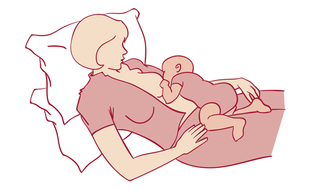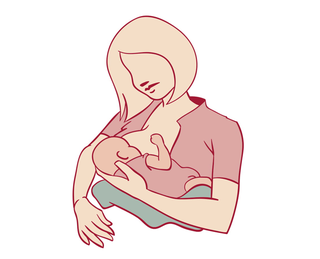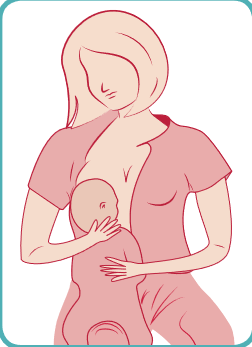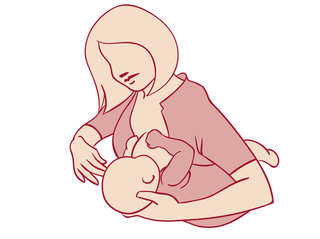Positioning and attachment are the terms used to describe how you hold your baby at your breast so they can feed. Attachment is also sometimes known as 'latching on'.
Correct positioning and attachment is the most important thing for successful breastfeeding. When your baby is well positioned and attached, they will find it easier to feed well.
In the early days of breastfeeding, you may feel nipple tenderness or sensitivity at the beginning of a feed as you get used to your baby attaching to your nipple. But it should not be painful.
Ask our breastfeeding experts
How to attach your baby
There are 2 ways to attach your baby:
- baby-led approach
- mother-led approach
Baby-led approach
The baby-led approach lets your baby use their natural instinct to latch on.
How to do it:
- Relax in the laid-back position.
- Lay your baby tummy-down on top of you, with easy access to the nipple.
- Let them find your breast and attach on their own.
Mother-led approach
If the baby-led approach does not work for you, you can take a more active role in helping your baby to attach. This is called the mother-led approach.

The following steps can help your baby to latch well:
- Hold your baby close with their nose level with your nipple.
- Let your baby’s head tip back so their top lip brushes against your nipple - this should help them open their mouth wide.
- When your baby’s mouth is wide open, bring them to your breast.
- Aim your nipple to the roof of their mouth.
- When they attach, your nipple and most of the areola (the area around your nipple) should be deep in your baby’s mouth.
- When your baby is attached properly, their chin will be pressed into your breast.
- Your baby's nose should be clear for easy breathing. Ideally, the nose should be at a tilt when attached correctly.
- Newborns are nose breathers. If they cannot breathe freely, they will come off the breast.
- In the correct position, your baby will be able to suck, swallow and breathe comfortably.
- If your baby's nose appears to be blocked, move their bottom closer to you. This will create a head tilt and free up their nose.
- The deeper the attachment the more comfortable you will feel and the better your baby will feed.
- More of your areola will be visible above their top lip than below their bottom lip.
- Their cheeks will appear fuller.
- They’ll suck quickly at first, followed by longer sucks.
- You will hear them swallowing.
Breastfeeding positions
Before you start breastfeeding, find a comfortable position. Like any new skill, this takes practice. There are very few rules but it is important that you and your baby are sitting or lying comfortably.
Try the following positions to see which works best for you and your baby.
Laid-back
Laid-back is a fantastic breastfeeding position. It lets you relax while your baby is able to attach easily to your breast. This is very important in the early days when you are both getting used to breastfeeding.

Laid-back is a great position to try if you are having difficulties with breastfeeding.
Here are a few tips to help you get your technique just right:
- The movement needed to get into this position is from your pelvis. Shift your hips forward in a chair or bed to create a semi-reclined position. Laying your baby down on your semi-reclined body ensures they connect with your body without any gaps.
- Lay your baby on top of you with their tummy down and their cheek resting near your breast.
- Allow your baby to self-attach. They will find the breast and attach themselves. You can also guide or help your baby to attach.
- You can use your arms as guard rails to support your baby on top of your body.
- You can also use pillows and cushions to provide support wherever you need it.
Important
Never fall asleep with your baby on a sofa or armchair as this increases the risk of sudden infant death syndrome (cot death).
Cross-cradle

- Hold your baby close and facing you. You may find a pillow on your lap helpful to support your baby.
- Gently support your baby’s neck, back and shoulders. This will allow them to tilt their head back easily.
- Do not hold or cover the back of your baby's head. This can result in them pushing back or arching leading to a failed attachment to the breast. It is important to create space for baby to tilt head back without obstruction for a successful attachment.
- Sometimes it helps to shape your breast, making sure your fingers and thumb are well back from the areola. This creates an oblong shape and allows your baby to attach easier to your breast.
- The palm of your other hand can support your baby’s back.
Koala-hold (straddle-hold)
Koala-hold position is good for babies with reflux, an ear infection, tongue-tie, low muscle tone, hip dysplasia or oversupply of breast milk.

This position is easier for babies who can sit unaided. You can use this position with a newborn if you give your baby plenty of support.
To do koala-hold:
- Your baby sits straddling your thigh or on your hip.
- Their back and head is upright while breastfeeding.
Mother and baby face each other either upright or semi reclined.
Football hold
This is a good position if you have had a caesarean birth.

- Support your baby’s neck, back and shoulders with your hand and wrist.
- Let your baby’s back lie along your arm. Your baby should be facing you with their nose near the nipple.
- Support your breast with your other hand.
- Guide your nipple towards the baby's mouth.
- Your baby will then snuggle up close and begin to breastfeed.
Side-lying
Side-lying involves lying down. It is good for night feeds

- You and your baby lie down facing each other.
- Make sure your neck and back are supported and comfortable. Your baby's chest should face your chest.
- Take the arm that you're lying on and either place it under your head or use it to support your baby by placing it under their head or around their body.
- You can use a pillow or rolled-up blanket behind your baby's back for support.
- Your baby’s nose will be near the nipple.
- From there, your baby will smell the breast milk, open their mouth wide and find the nipple.
- Make sure your breast is deep in your baby's mouth (ideally at the junction of the hard and soft palate).
How to know your baby is attached correctly
Signs that your baby is attached correctly:
- Your baby should have a wide mouthful of breast in their mouth.
- Their chin should be touching your breast.
- You may notice their top and bottom lips curled out.
- Their cheeks should be full and rounded - you should not see the cheeks dimpling when your baby sucks.
- Their jaw should be moving, you may also see their ears twitch as they feed.
- They will start with short quick sucks, then change to long deep sucks with pauses to breathe.
- You should hear them swallowing as your breast milk volume increases.
- You should not hear smacking or clicking sounds.
- They should feed calmly and not move on and off the breast.
- Your baby finishes feeding and seems satisfied.
- You will feel comfortable during a feed and your nipples should not be sore.
Don't
-
do not push your baby onto your breast during latching if you can avoid it
-
do not check your baby's lips after latching - this will pull your breast out of their mouth
-
do not cover or restrain your baby's hands
-
do not touch the back of your baby's head - this can cause them to push back
